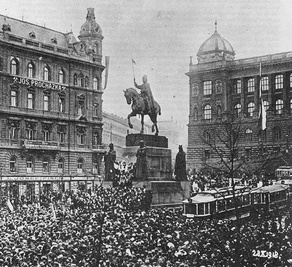
First Czechoslovak Republic
The First Czechoslovak Republic was a state formed on the ruins of the defunct Austro-Hungarian Empire in 1918. It was founded thanks to top Czech politicians lead by future President Tomáš Garrigue Masaryk. The First Republic came to an end during the occupation of the Sudetenland in 1938,folowing the forced acceptance of the Munich Treaty signed by President Edvard Beneš.
Czechoslovakia was declared a republic by Prague National Council on October 28, 1918. The country acquired fixed borders as late as in 1920 and Tomáš Garrigue Masaryk became the first President. This was after territorial disputes, primarily concerning borders with Hungary, later with Poland about the Těšín Region, and with The Soviet Union about the Sub-Carpathian Ruthenia. All disputes were solved with the help of the Czechoslovak Army. In the twenties of the 20th century, Czechoslovakia belonged to the top ten industrial powers in the world. The industrial core was mainly in the Czech part of the country, as opposed to Slovakia and Sub-Carpathian Ruthenia which were mainly agricultural.
The political situation in Czechoslovakia gradually stabilized. During the First Republic, the government was parliamentary with a coalition of five major parties, led by the Agrarians. Originally, only Czechoslovak citizens were part of the government; however, in 1926, even Germans and other members of minorities could participate. The Hungarian minority never reached the government level. President Tomáš Garrigue Masaryk was repeatedly elected until 1935 when he resigned for health reasons, he was replaced by President Edvard Beneš.
Under Masaryk, Edvard Beneš was Foreign Minister and the international politics was his agenda. Beneš tried to create a system of alliances to protect the frail Czechoslovakia against bigger aggressors. In 1920 and 1921, Czechoslovakia joined Romania and the Yugoslav state in the Little Entente, whose goal was to prevent the return of Habsburg and Hungary.
He also cooperated with Britain and France, and in 1924, he signed a treaty of mutual defense with France. The Locarno Treaty in 1925 showed the rise in strength of Germany within the scope of the United Nations, and it complicated the cooperation between Czechoslovakia and France. In the times of emerging Nazism, and after Hitler´s accession to power in Germany, Beneš made efforts to seek help from The Soviet Union which he hadn´t been in favour of earlier. In 1935, an agreement was signed stating that if France helped, so would Stalinist Russia. Nonetheless, when most needed, the hope for help from Western Powers didn´t materialise and Beneš was forced to sign a humiliating Munich Treaty, which was the start of the disintegration of Czechoslovakia. Germans occupied the Sudetenland at the end of September 1939, and the era of the First Czechoslovak Republic ended, closely followed by the Second Czechoslovak Republic, which lasted only six months (1939 to 1939) as Germany turned Bohemia and Moravia into a Protectorate of the German Reich enforcing the decision with occupying forces.
The First Czechoslovak Republic is closely connected to the person of Tomáš Garrigue Masaryk, who has been possibly overidealized (even if with good reasons). One must understand that despite the impressive success of the First Czechoslovak Republic, there were a number of problems, which were all related to the national diversity of the country. The problem with minorities (Hungarians, Germans, Gypsies, Russians, and Jews) seriously undermined the country´s stability.The largest minority, the Germans, was also the most radical. The problem also escalated because of a non-negotiable politics towards minorities concerning top position within the State Administration. This combination of domestic problems, outside aggressor (Hitler's Germany) and the indifference of powers (France, Britain, and Soviet Union) led to the end of the First Czechoslovak Republic.









